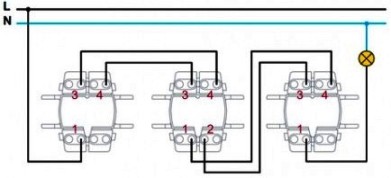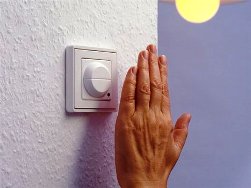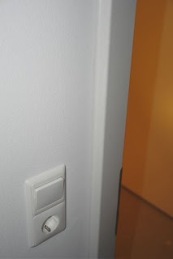Categories: Featured Articles » Sharing experience
Number of views: 32446
Comments on the article: 0
How to use switches
 It is no secret that any wiring series without switches is defective. And though switches far from the most popular mechanisms, comfortable wiring without their use would be more complicated and less interesting.
It is no secret that any wiring series without switches is defective. And though switches far from the most popular mechanisms, comfortable wiring without their use would be more complicated and less interesting.
The main application, which is offered "from the manufacturer" (such schemes are present in many catalogs) is multi-spot lighting control. Yes, indeed - turning the bulb on and off from different points is very convenient, but the control process is not always straightforward with switches.
And the thing is this:
Lighting control in the apartment - there is a comfort function. Management should be clear and inconspicuous. Do not distract attention for simple actions.
Try to calculate how many times a day you press the switch key. And how often do you think before you press it?
Infrequently, right? By the way, for this reason, the introduction of “smart homes” is still in the same place as 40 years ago, from the moment the idea was born to transfer the principle of the conveyor from production to housing.
You simply come and turn on the light, acting at the subconscious level, realizing that up is on, down is off. You can not even look, but simply be guided by tactile sensations. This will not work with the switches, since the position of the key will be completely uninformative, and it depends only on the position of the other switches in the circuit, which the diagram clearly demonstrates:

Since the main part of the controls (within the apartment, for example) are ordinary switches having two fixed states “up” and “down”, respectively “on” and “off”, the switches will destroy the homogeneity of the environment.
To prevent this from happening, to control the lighting from several places, use the and buttons impulse relays. Also many push dimmers have a pulse input and allow you to control yourself with buttons.
 All these mechanisms - be it a button, a switch, a switch, Dimmer as part of one series - they look the same outwardly.
All these mechanisms - be it a button, a switch, a switch, Dimmer as part of one series - they look the same outwardly.
The place of the switches in modern wiring is slightly different than originally expected, and differs from what the well-known schemes from catalogs offer, although such an application has not yet completely worn out.
It is much more convenient to use a switch (however, in its place there may be a rotary push dimmer with a switching contact) for switching two different circuits.
For example, in the upper position of the key, the upper light turns on, let it be a chandelier, in the lower - night illumination. The only thing worth considering is that at least one of the circuits must be switched according to the condition (we don’t need light all the time?) Illumination can become such a condition, if it is below a preset threshold, then turn on the backlight, no, then we wait.
Physically, an idea can be implemented by incorporating “smart” into the chain Motion Sensor, and, if it also has a manual control function, this will allow you to control the night illumination from different places.
 A simpler example:
A simpler example:
In many apartments, the entrance group consists of two old wooden and external metal doors. Each time, when the first door is unlocked from the entryway, they rest against the second, already encountering insufficient lighting. Let's try to make this process more comfortable.
We will need the most ordinary three-wire motion sensor and lamp, which should be installed in the opening between the two doors. When you open the door, a motion sensor detects infrared radiation from your body and turns on the light. Unlocking the second door becomes much nicer.
Such a solution can significantly increase security. If someone wants to enter the apartment with you, he, seeing the light outside the open door, will assume that there are other people in the apartment, even if in reality this is not so at all.
The switch here is needed in order to turn on the light in the hallway in one position, and in the other to supply power to the motion sensor between the doors and with the second door open, to avoid annoying blinking of the bulb every time you pass through the hallway.
Alexey Pichugin
See also at bgv.electricianexp.com
:
